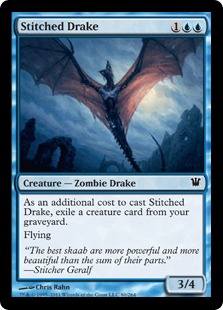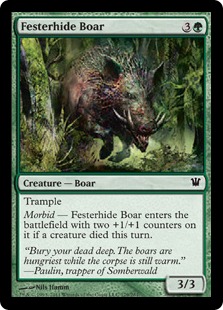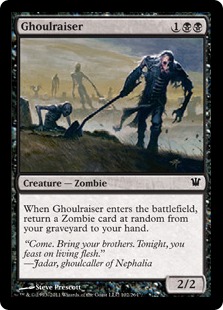With the upcoming release of
Theros, Innistrad Block will finally rotate out of Standard, taking with it some of the most powerful and popular Commons in Standard Pauper. So, to help commemorate this very successful set, this coming Monday will feature a special edition of Monday Pauper Deck Challenge. This event will be an
Innistrad Block Pauper tournament, which obviously means that only Commons from Innistrad Block will be legal.
I don't know about you, but I think this is a great idea! So today, I
thought I would highlight what I believe are the strongest archetypes
for just such an event.
 1. White Weenie
1. White Weenie
In my opinion, probably the deck to beat for this event will be White Weenie. The block features some of the best White creatures available, including
Chapel Geist,
Loyal Cathar, and
Seraph of Dawn, just to name a few. Back these up with a mix of decent removal spells and combat tricks, and you have quite the potent combination. There's a reason that White Weenie has dominated the format for several months now, and the White Commons from Innistrad are a big part of that.
2. Black/White Sacrifice
On a similar note, one might instead add Black to the mix, netting a stronger suite of removal spells (such as
Victim of Night) and utilizing cards such as
Altar's Reap,
Falkenrath Torturer, and
Thraben Sentry to craft a game plan around sacrifice effects, taking advantage of Morbid triggers and the like for a more controlling approach, but one still capable of assembling a powerful advantage over your opponent. While such a build hasn't seen much play of late, this was once a popular and potent archetype.
3. The Rock
Another possibility is to take those same Black cards and instead pair them with Green to create a deck that overwhelms an opponent with a powerful army of fatties (such as
Festerhide Boar), fueled by Undying creatures like
Butcher Ghoul or
Young Wolf and boosted with the very powerful
Hunger of the Howlpack. Green and Black have traditionally paired quite well together in an archetype known as
the Rock, and I personally think Innistrad Block could be quite good for just this sort of strategy.
 4. MonoBlue Flyers
4. MonoBlue Flyers
Another popular choice when Innistrad was first released was an early version of MonoBlue Flyers, that combined powerful Blue creatures like
Delver of Secrets,
Stitched Drake, and
Stormbound Geist with classic Blue control elements like
Think Twice and
Silent Departure. Like its recent counterpart in Standard Pauper, this is a potent combination. While this version probably isn't as overwhelming as its current iteration, it should still serve as a strong choice for Innistrad Block.
5. Zombies!
And last but not least, this is the final chance to play with the excellent Zombies available in Innistrad, from the sole remaining
Gravedigger in Standard to the excellent
Stitched Drake to the fearful
Highborn Ghoul. Throw in some cards that utilize the Graveyard like the aforementioned
Think Twice or
Forbidden Alchemy, and you have a controlling build that might just be able to stand up against any other deck in the format. I've played variations of this deck often, and more often than not this will be my deck of choice for next Monday!
So did I miss any strong archetypes? Does this inspire you to play in next's week MPDC, or are you just anxious to finally see these cards rotate out of the format. Let me know what you're thinking in the comments below. See you next time.

















